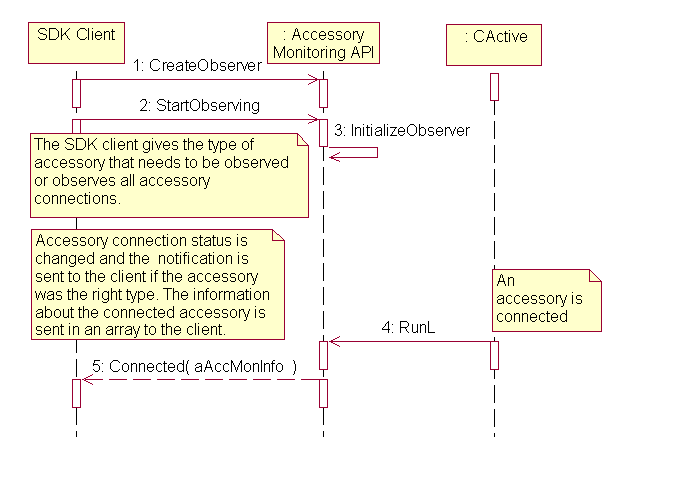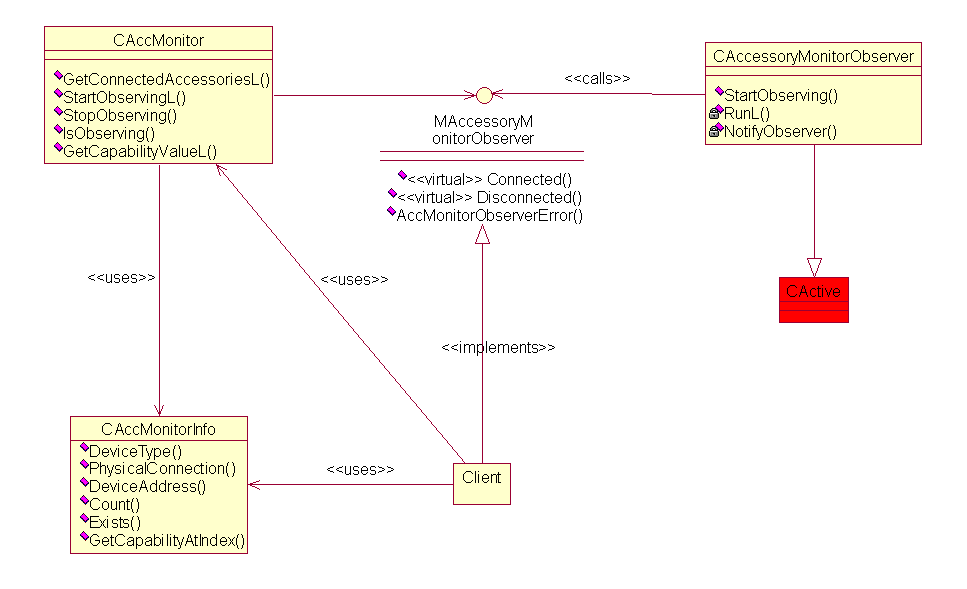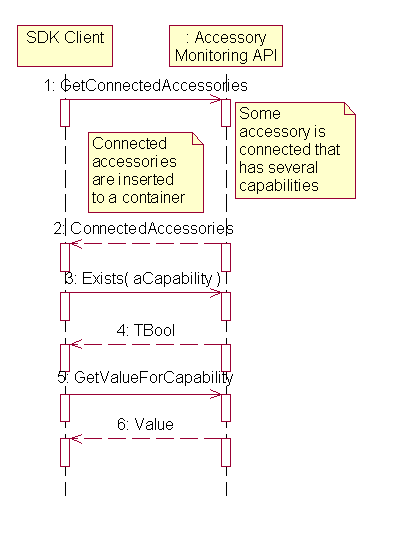accessory monitoring api Specification
Contents |
1 Overview
API for monitoring accessory information
| API category | public |
| API type | c++ |
| API libraries | accmonitor.lib |
| Location | /sf/os/deviceio/deviceio_pub/accessory_monitoring_api
|
| Buildfiles | /sf/os/deviceio/deviceio_pub/accessory_monitoring_api/group/bld.inf
|
1.1 Description
This API is intended to be used by clients that need to access information about connected accessories or clients that need notifications about accessories that connect or disconnect to the device. The API provides stand-alone implementation units that are used by clients.
1.2 Changes
The Accessory Monitoring API is introduced in Symbian OS, S60 5.0.
1.3 Use Cases
- Retrieving connected accessories.
- Retrieving accessory capabilities.
- Retrieving capability values.
- Listening for all accessory notifications.
- Listening for accessory type notifications.
- Listening for specific accessory notifications.
- Handling connected or disconnected notifications.
1.4 Class Structure
| Classes | Files |
|---|---|
|
/epoc32/include/AccMonitor.h
CAccMonitorInfo /epoc32/include/AccMonitorInfo.h, /epoc32/include/AccMonitorInfo.inl
MAccMonitorObserver /epoc32/include/AccMonitor.h
/epoc32/include/AccMonitorCapabilities.h
The CAccessoryMonitor class in Accessory Monitoring API
provides functions for retrieving connected accessory information and listening for the
accessory connection notifications. The client must implement the MAccessoryMonitorObserver class
to receive accessory connection or disconnection notifications. Information about
one accessory is wrapped to instances of class CAccMonitorInfo .
Accessory capability definitions for Accessory Monitoring API are declared
in the accmonitorcapabilities.h file.
2 Using The API
The Accessory Monitoring API can be used in:
- Retrieving the accessory information
- Listening for accessory connection or disconnection notifications
Accessory information from Accessory Monitoring API is presented as instances
of the CAccMonitorInfo class. This class contains accessory
capabilities and these capabilities describe the features of one accessory.
Some capabilities can be defined more precisely by defining values to these
capabilities. These values can be asked from the Accessory Monitoring API.
Accessory connection or disconnection notifications can be listened for using the StartListeningL() method.
Connection notifications on client side are received from the MAccMonitorObserver class.
The client must implement the pure virtual functions from this class. Connection
notifications are received through the ConnectedL() method
and disconnection notifications are received through the DisconnectedL() method.
2.1 Retrieving the accessory information
2.1.1 Retrieving all connected accessories
Clients create an instance of the CAccMonitor class
and calls the GetConnectedAccessoriesL() method. This method
returns all connected accessories in an array that contains instances of the CAccMonitorInfo class.
The following example shows how to retrieve accessory's information from the arrayÖ
CAccMonitor* accMonitor = CAccMonitor::NewLC();
RConnectedAccessories connectedAccessories;
CleanupClosePushL( connectedAccessories );
accMonitor->GetConnectedAccessoriesL( connectedAccessories );
count = connectedAccessories.Count();
for( TInt i = 0; i != count; i++ )
{
if( connectedAccessories( i )->AccDeviceType() == KAccMonHeadset );
{
_LIT( KHeadsetText, "A headset is connected" );
RDebug::Printf( KHeadsetText );
}
}
CleanupStack::PopAndDestroy( &connectedAccessories );
CleanupStack::PopAndDestroy( accMonitor );
2.1.2 Retrieving accessory capabilities
Clients retrieve the capabilities information from an instance of CAccMonitorInfo All the accessories capabilities are owned by this instance. Use AccCapabilityAtIndex() to retrieve one capability as shown in the following example:
// Connected accessories are retrieved as shown in the previous example.
const TInt lastConnectedAccessory( 0 );
// The accessory that was connected last is first in the array
cAccMonitorInfo* accInfo
= cAccMonitorInfo::NewL( connectedAccessories( lastConnectedAccessory ) );
for( TInt i = 0; i != accInfo->Count(); i++ )
{
if( accInfo->AccCapabilityAtIndex( i ) == KAccMonStereoAudio )
{
// Some accessory has stereo audio capability
_LIT( StereoText, "Stereo audio can be played to some accessory" );
RDebug::Printf( StereoText );
}
}
delete accInfo;
2.1.3 Retrieving the capability value for an accessory
Clients can retrieve a value for a capability using the CAccMonitor class's GetCapabilityValueL() method.
// Connected accessories and their capabilities are retieved in previous examples TAccMonitorCapability capability( KAccMonVideoOut ); TInt value( 0 ); accMonitor->GetCapabilityValueL( accInfo, capability, value ); // Capability value is retuned to value variable
2.2 Listening for accessory connection or disconnection notifications


